Introduction
This week's theme is drawing in the context of computer generated imaging. We take a look at a historic episode of The Simpsons where Homer transforms from a 2-D character to a 3-D character. We reflect on this as being a milestone moment for animation, being symbolic of the coming of age of computer-based modeling and a revisiting of the Renaissance representational endeavour in art through its ratification of Cartesian 3-D drawing space.
We take a retrospective look at image highlights from the early days of emergence of computer imaging and we study how the development of drawing and image manipulation software virtualised the tools, practices and techniques not only of artists and photographers but also of typesetters and graphic reproducers.
The programs commonly used for creating and synthesising images make use of a wide range of software tools, many of which relate to traditional manual tools and practices. There have emerged two fundamental image formats for working with 2-D images: vector and raster. Most computer graphic software these days enables one to work with both of these modes and indeed to work interchangeably between them. Some enable the incorporation of 3-D modeling formats too and the 3-D programs can utilise the 2-D formats. What this means is that the virtualisation of the graphic processes has reached a stage where the work can flow easily between spaces and places and it can readily be electronically shared.
This week we also take a look at the pioneering work of Dr Stuart Campbell (aka Sutu) in the emergent fields of interactive comic book, augmented reality (AR), virtual reality (VR) and mixed reality (MR).
Flatland Homer versus Homer cubed
Ever since Fox commissioned the first series from Matt Groening in 1989 the animated cartoon The Simpsons has become a staple in the TV-watching diet of families throughout the Western world. A large part of its generation-spanning success can be attributed to its adherence to all of the finest of the long-established traditions of lampooning, caricature, cartooning and comicry. These include:
- desire to entertainment audiences
- consistent characterisation and sympathetic portrayal of character’s emotional responses
- nobody-spared, no-holds-barred, irreverent satirical attitude
- disrespect for authority figures
- empathy for ‘common’ people (typically the largest subset in today’s consumer society – the ‘upper-lower-middle class’)
- highlight of contemporary issues
- satire of socio-cultural double-standards and ironies
- in-jokes for cult and specialist genre audiences, self-referential gags and references to other texts
- repetition of popular gag formats and segments (e.g. the couch, the blackboard, itchy & scratchy)
In addition The Simpsons’ writers employ all of the tropes discussed in Lecture 8 including: analogy and metaphor; metonymy; hyperbole; strange juxtapositions and combinations; symbolism and allegory; personification; typology; and, allusion.
Stylistically, The Simpsons cartoons are drawn using line to create outline shapes with flat, colour filled areas.

In general, concessions to form amount to implementation of a three-tone range that includes a band of highlight and a band of shadow, thus creating a suggestion of tonal depth. For example see:

This means that the characters retain flat and two dimensional presences. Elementary foreshortening is implemented, along with other depth cues, for example: overlapping, diminishing size, vertical location, convergence, textural changes, aerial perspective and zones of depth (these have been discussed in Lecture 4).
In a critique of the cultural implications of the perseverance of a graphic animation style that had emerged with the earliest of animated films Anna Munster suggests that the graphic flatness reflects a view of the world dissociated with concern for reality.
By stripping the volume away from animated characters’ bodies, the organicism depreciated and direct abject confrontation with bodily functions could be avoided, returning animation to an emphasis on what Norman Klein has called ‘graphic narrative’. Klein examines the early history of animation, exemplified by the "Felix the Cat" cartoon series of the 1920s, indicating the presence of an initial anti-realist aesthetics that leaned towards the flattened planes of the x, y axes of screen space, and sacrificed the illusion of character depth provided by perspectival space and the fully developed narrative, for the rhythm of line movement and the fracturing effect on plot development performed by the visual gag.
(Munster, 2003)
In 1995 an experimental segment of The Simpsons was produced using computer-based 3-D modeling and rendering techniques. Entitled Homer3 and included as part of the Treehouse of Horror VI episode this segment created a sensation. It was produced by a company called Pacific Data Images (PDI) which, during the 1980s had been using Computer Aided Design (CAD) tools to produce mainly computer animated logos and commercials, and had begun working with computer-generated special effects for movies in the early 1990s. PDI was later incorporated into the company Dreamworks which has since produced the 3-D animated movies, Antz and Shrek, Shrek 2 & Shrek 3 and a number of other movies using both computer generated imagery (CGI) and traditional animation techniques.
In the 3 ½ minute segment Homer is hiding in a closet and accidentally passes through the wall into another ‘universe’ that fellow Simpsons character Professor Frink, when called upon to explain, describes thus:
Well, it should be obvious to even the most dim-witted individual who holds an advanced degree in hyperbolic topology, n'gee, that Homer Simpson has stumbled into... the third dimension. [drawing on a blackboard] Here is an ordinary square…but suppose we extend the square beyond the two dimensions of our universe (along the hypothetical Z axis, there). This forms a three-dimensional object known as a "cube", or a “Frinkahedron” in honor of its discoverer, n'hey, n'hey.
(Adapted from The Simpsons script excerpt cited at: http://www.mathsci.appstate.edu/~sjg/math/mathsimpsonstext.html#3dhomer)
Following is a sequence of images showing how the animators handled the homer’s transformation of Homer as he trips from the familiarity of his ‘flatland’ story space into a Cartesian nightmare:
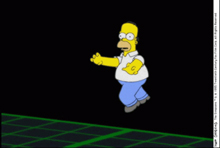
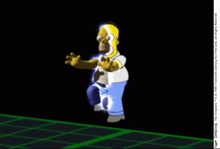
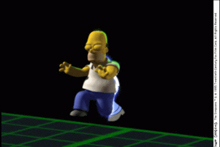
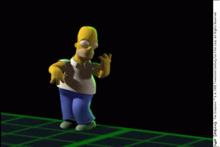
Source: Treehouse of Horror VI episode, The Simpsons, 1995
© Matt Groenig, Twentieth Century Fox Film Corp
The Homer3 segment was significant in that it heralded the ‘coming of age’ of 3-D computer generated character animation. The highly acclaimed Disney/Pixar movie Toy Story was released in the same year. Toy Story is widely recognised as the first feature-length 3-D character animation. In the decade since, the processing power of computer hardware, the storage capacity of computer media, the algorithmic complexity of software and the sophistication of modeling and rendering techniques have continued to develop. 2-D and 3-D computer generated imagery production is today so accomplished that there is no boundary between the filmic ‘real’ and the filmic fantastic. Virtual, 3-D modeled CGI characters interact with human actors. New feature films and computer game renderings are constantly pumping the desires and expectations of audiences; creating demand for demonstration of ever greater wizardry.
But what is the difference between the 2-D Homer and the 3-D Homer? Stylistically what we can say is that the form of the 3-D Homer is modeled using continuous tone to represent light falling over a voluminous surface; that the highlights and the shadows cast have physically realistic logic. The form of the character likewise maintains morphic consistency regardless of the angle of view, and indeed the point-of view ranges more dynamically than in 2-D animation. And all of these aspects transform temporally in a consistent and congruous manner. The shape of the character is not defined using contour lines as in 2-D because all of the above-mentioned cues are sufficient to establish the illusion of form.
Precision versus expression "a terrifying thing"
The creative team from PDI in a short excerpt from “The Simpsons” Complete Seventh Season DVD express the difficulty they had in working with pre-existing 2-D characters, rather than if they were to have invented the characters from scratch. Creating a model for Bart’s hair in particular was, they say, “a terrifying thing” because of the way it is “cheated and used in 2-D animation”. By this I think they mean that the hair can be more expressively suggested in 2-D whereas the modeling technique for the 3-D version required more precise geometric definition (these days fuzzy logic and particle algorithms may provide solutions in this area). In the end they say that they resorted to finding an existing 3-D interpretation in the form of a vinyl Bart doll and that they “built" that on the computer. This highlights the technical and procedural differences in regard to production of the animated 3-D movie itself compared to traditional animation technique. It is not simply a matter of being computer-based art. Indeed, from around the same time as Homer3 was produced (mid 1990s) the traditional ‘cells’ of the 2-D animated Simpsons have been coloured and rendered using computer graphic software and hardware. Rather, the key difference is that the 3-D version is a virtual model situated in virtual Cartesian space. The model can be programmatically manipulated and filmed using a virtual camera in the setting or background which is also constructed as a model space, in other words, a ‘virtual world’.
Fundamental reliance on hand-drawn visuals
The interview with the PDI team also highlights the common basis from which both the 2-D and the 3-D modes of production arise—the sketched visual and storyboard! As has been shown with many references throughout this course, even the most computer intensive production environments still rely fundamentally on hand-drawn visuals for the purposes of: concept generation, idea-proofing, characterisation, script and narrative development, cinematographic planning, set and property design and so on. The quick, efficient and direct manipulation, the scriptonic expression and the spatial and structural flexibility afforded by drawing is irreplaceable in the iterative process of appraisal and refinement of these foundational elements and for their communication and sharing with specialist design development and production teams.
Virtualisation of drawing tools and practices
Having established that the contemporary ubiquity of CGI does not spell the impending obsolescence of pencil and paper let us now take a look at how the utility of traditional drawing and painting tools and practices has been virtualised in common graphic creation, manipulation and synthesis tools. Once we understand this notion it becomes easier to slip readily between dextrous and digital modes of drawing and visualising, being able to combine techniques and use hybrids and combinations of manual and electronic methods.
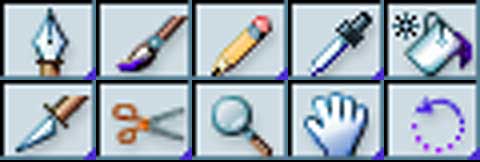
It is important to understand that the virtual is not simply the sublime working space of computers and networks. It is inherent in everything we humans do. French philosopher Pierre Lévy says that “a tool is more than just an extension of the body; it is the virtualisation of an action” (Lévy 1998, p 95). He says that virtualisation is an identity shift from a particular solution or activity to a more general problem, function or goal.
[…T]he virtualisation process detaches some action or effect from one organ, some flesh and blood machinery and identifies a general function. Then, this isolated function can have hundreds of different actualisations and can combine with other actualisations of other functions. So, the body comes out of the body, it acquires new speeds, it pours itself into its outside and its outside into itself, it multiplies itself. This process is not at all a disembodiment but, on the contrary, is a complex re-embodiment, an heterogenesis of the body.
(Lévy 1995)
Over the half century during which the evolution of computing has seen computers shrink from room-size to notebook-size many logical and abstract processes, manual procedures and techniques, and work practices have been computerised. Since the mid-1980s there have been practical and affordable drawing and painting tools available for the personal computer.
Illustrator™ and Photoshop™ emerged out of two different traditions: one pertaining to the graphic arts, and the other pertaining to photochemical darkroom practices.
Interestingly, the latter tradition had already once transformed the practices of the former, in a technological revolution a century prior to the coming of digital age.

Prior to photo-engraving printing plates were etched by hand
Photoengraving for graphic reproduction involves making films of the text and image content of pages. These are then used to photographically expose lithographic printing plates. The plates are pre-coated with light sensitive emulsion in such a way that they can be treated with acid to etch an impression corresponding to where the films have blocked exposure. When wrapped around a drum on a printing press, the impression on the plate takes printing ink and transfers it to paper in a repetitious manner at high speed.

The photo engraving process
Finished artists were specialists who arranged the various typographic and illustrative elements onto a piece of cardboard called a pasteboard. They would invariably be working to a designer’s layout sketch or visual. The finished artist was not necessarily a creative person but, more likely, a perfectionist with an eye for spatial balance, squareness to grid, and detailed accuracy. The artwork assembled was temporary and often discarded after the making of the films. Setting type for the finished artist was also a specialist task. A designer would measure up and estimate how the copy would fit on a page and the order type ‘galleys’ from a typesetter for the finished artist to cut up and stick down with removable rubber cement onto the paste board. If there were any errors in the copy or resulting from the task of copy-fitting, new type galleys would be required from the typesetter. This stage of preparing pages for print was labour intensive and often an expensive process
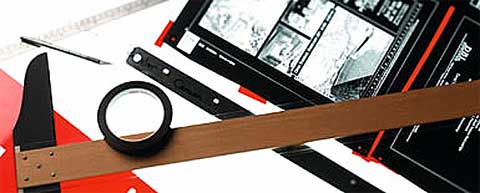 .
.
The compositors tools
PostScript is a page description language, a protocol that is used to communicate between applications (like Illustrator, Photoshop, or MS Word) and output devices, like laser printer or imagesetters, that are equipped with a PostScript interpreter. It is a high level computer programming language. PostScript can also be used to exchange data between applications themselves and it forms the basis of the PDF file format.
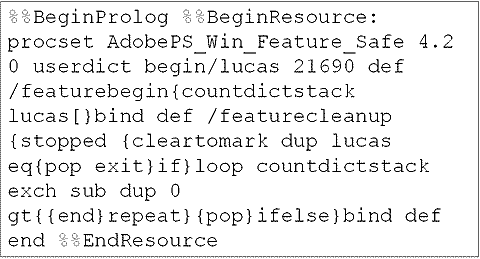
A sample of PostScript
First released in 1984 by Adobe, then a small company founded by John Warnock and Chuck Geschke in California, PostScript is a language for printing devices. Dovetailed to the processing capability of the Apple Macintosh computer new software programs that also utilised PostScript software capability provided a means to virtualise nearly all of the laborious and materially costly steps in graphic arts and reproduction from design to print. Importantly, with WYSIWYG screen visualisation, the process could remain digital until output, allowing previously unheard of creative flexibility. Proofing via laserwriter gave accurate rendition of anticipated result and was comparatively inexpensive. Since then, a digital revolution has swept graphic design, graphic reproduction and publishing industries.
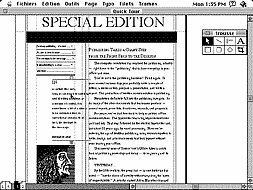
Early Aldus Pagemaker on the Mac
The first desktop publishing software to emerge was Aldus Pagemaker™ in 1985. This was followed by Adobe Illustrator ™ in 1987 and, Aldus Freehand ™ in 1988. These programs all use the finished artist’s paste-up board as their primary metaphor and deploy virtual implementations of common graphic arts tools and procedures. They were originally used for combining typographic and illustrative (line and tone) elements. They all use PostScript to interface with each other and to output devices. Illustrator and Freehand also enable complex trapping, spreading/choking and overprinting controls necessary for accurate colour separation for litho and screen printing.
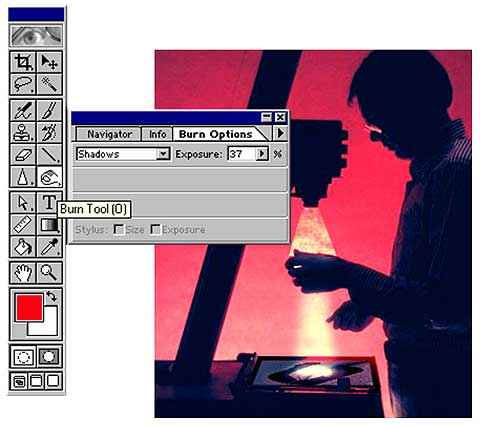
The darkroom technique 'burning' virtualised in Photoshop
The development of image processing software coincided with that of DTP tools. However, father and sons, Glenn, John and Thomas Knoll, waited until 1990 for the first commercial release of their work as Adobe Photoshop™. Apart from the obvious complexities of the task, the delay is attributed in part to the fact the earlier PC monitors could not accurately display greyscale tones, and in part to the necessity to develop gamma correction algorithms to maintain consistent standards between devices. The primary metaphor for Photoshop and other image processing and editing software is the darkroom. Virtual implementations of common photographic tools and procedures are deployed.

Making a mask in Illustrator virtualises a physical masking technique
With changes implemented in successive versions desktop publishing and image processing software, especially in response to demand for new tools for multimedia and web developers who work outside of the traditional print paradigm, the differences between programs like Illustrator and Photoshop have become less distinct. This process can be seen as being in line with an overall socio-technological trend known as media convergence. However, deep down inside Illustrator and Photoshop there remain the fundamental distinctions derived from the work practices and tools of the respective traditional disciplines and crafts that these software tools virtualise.
The second reading for this week, Software makes its mark: trademarks of the dawning computer era, traces the history of the development of computing and computer graphic hardware and software and juxtaposes milestone events on a timeline along with samples of trademarks registered in Australia during the same period. The author identifies certain qualities and characteristics in the sample trademarks that he believes are attributable to the impact of computer graphic techniques. Interestingly he also believes that there are ideas and concepts expressed in trademarks that anticipate the technical capacity to produce them that computerisation enabled.
Working between manual and digital workspaces
This unit was developed to respond to an identified need to reintroduce a focus on the manual and intellectual processes that facilitate efficient idea generation and sharing in the creative communication team environments. In workplaces where computers are ubiquitous the level of familiarity with fundamental coordinated hand and brain techniques seems to be reaching an all time low. Thus, in an effort to enable students to gain confidence in the necessary skills in was decided to develop tutorial exercises that where the hand drawing techniques were practiced in isolation from the computer-based techniques that may otherwise also be relevant. This approach entails an opposite risk, that students may miss out on understanding how the dextrous and the computer-mediated work flows mix and mingle in real-world working situations. For example, the authors of the first reading in describing the work flow of the production of the animated 3-D movie Toy Story , tell of how the storyboard visuals are placed into the temporal workspace and are gradually superceded with iterations of product development stages.
Other examples of hybrid techniques, of the use of either the manual or the digital workspace for specialist tasks, and of how the two spaces may be combined include:
- The use of the pressure sensitive stylus and digital drawing tablet for drawing lines of variable weight directly into the digital workspace.
- Graphic design and page layout directly on computer.
- The use of layers in drawing and image manipulation programs to enable efficient tracing (including drawing over photos as source reference) and montage techniques.
- Auto tracing utility
- The use of scaling and transformation tools to resize and/or reflect and/or distort images as interim drawing steps.
- Use of stock images in computer layout mock-ups.
- Scanning of hand drawn visuals to form the basis for computer-based finished drawing.
- The use of rotoscoping techniques to map human movements and expressions into animated cartoon production workspace
Hyperimage
In the contemporary, there is widespread recognition that media convergence is leading to the merging of discrete media and their associated work practices. This is one of the characteristics of what is understood by the term ‘new media’. In this convergent environment the ‘old media’ do not disappear, they co-exist with the new. But new possibilities for communication arise, and new forms of images emerge, some of which cannot be experienced except by computer mediation. I call these new and emergent image forms hyperimage.
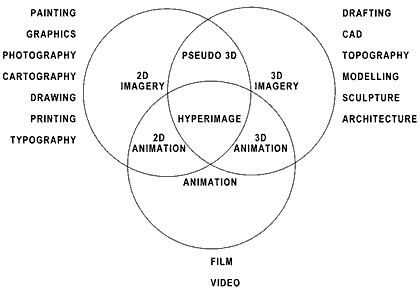
Hyperimage and its antecedents
Hyperimage exists at the intersection of 2-D imagery, 3-D imagery and moving image mediums. The older discrete media do not dissappear. They still exist as forms in themselves. But they have also been incorporated into the domain of hyperimage. One quality of hyperimage is that its unique properties cannot be appreciated except by computer mediation.
Drawing the future - now
Illustration has secured its place as a medium of expression suited to emergent technologies such as interactive comic book, augmented reality (AR), virtual reality (VR) and mixed reality (MR). CQUniversity Australia has conferred an Honorary Doctorate in Digital Media. The recipient is trailblazing Australian illustrator and interactive designer, Dr Stuart Campbell.
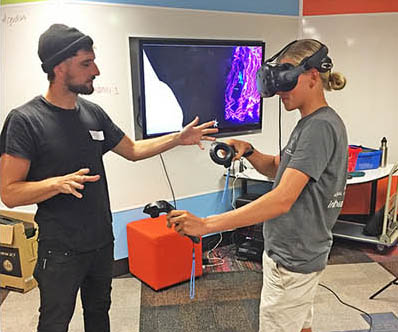
Dr Stuart Cambell (aka Sutu) assisting a student using a Google Tilt Brush
Leading the way in this millennium Dr Campbell (aka Sutu) has received a string of awards for his innovative experiments and collaborations. This CQUniNews article reports on a workshop he conducted in Noosa in 2017. See the left side-bar for links to examples of Sutu's work and interviews with him.
References
Lévy, P., 1995, “Welcome to Virtuality”, Ars Electronica Archives, http://www.aec.at/en/archiv_files/19951/E1995_091.pdf
Lévy, P., 1998, Becoming Virtual. Reality in the Digital Age. Bononno, R. (Tr), Plenum Press.
Munster, A, “Comprehension and the Intensification of Visual Information in Flash Aesthetics”, in MelbourneDAC 2003 pp135-143. Munster cites Klein, N. Seven Minutes: The Life and Death of the Animated Cartoon, London, 1993
Sayre, R., Barzel, R., Quade, R., & Hickel, H., 1995, Pixar and Disney's
Toy Story, presentation at Silicon Valley, ACM SIGGRAPH, http://silicon-valley.siggraph.org/MeetingNotes/ToyStory.html






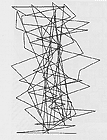



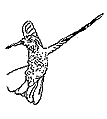
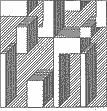













 .
. 




